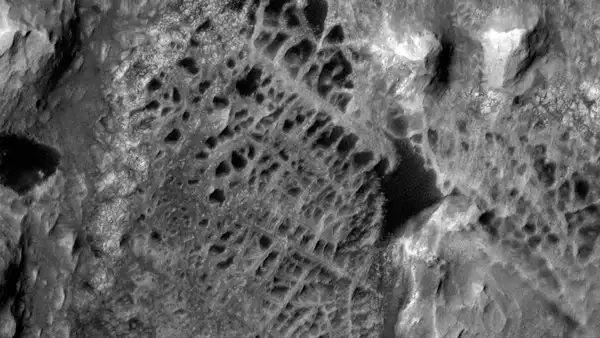NASA’s Curiosity rover has captured the first-ever close-up images of strange, spiderweb-like rock formations on the surface of Mars. These formations offer new clues about the planet’s ancient, watery past. The mysterious zig-zagging structures, known as “boxwork,” were discovered on the slopes of Mount Sharp inside Gale Crater, where Curiosity has been exploring since 2012. These intricate mineral-rich ridges likely formed from ancient groundwater activity and resemble webs when viewed from above. Scientists hope these formations may hold vital clues about Mars’ potential to support microbial life in the distant past.
What are Martian “spiderwebs” that are captured by NASA?
Despite their nickname, the spiderweb-like structures aren’t made by Martian insects. They are geological features known as boxwork, a pattern of intersecting mineral ridges that form when groundwater seeps through cracks in rock, leaving behind mineral deposits. Over time, wind erosion removes the surrounding softer rock, revealing the hardened web-like framework underneath.

A first in Martian exploration
While boxwork formations have been seen from orbit, this marks the first time they’ve been examined up close on Mars. Curiosity reached the site in early June 2025 after months of navigating Mount Sharp. NASA released the images and a 3D interactive video of the formations on June 23, describing them as a top scientific priority due to their unique structure and unexplained location.

What the rocks reveal about ancient Mars
Analysis of the surrounding rocks shows veins of calcium sulfate, a salty mineral commonly left behind by groundwater. These findings suggest the area was once rich in liquid water, and the underground environment could have been warm and salty—potentially hospitable to microbial life, similar to some regions on early Earth.
Not the first ‘spiders’ on Mars
The newly imaged boxwork formations should not be confused with the so-called “spiders on Mars” — dark, radial patterns caused by carbon dioxide ice erupting from beneath the surface. Unlike those seasonal features, boxwork is permanent and mineral-based, formed through geological—not atmospheric—processes.
Could this mean Mars once supported life?
Scientists believe these formations could help settle the debate over whether Mars once harbored life. The mineral composition, protected underground conditions, and evidence of flowing water all point to an environment that could have supported microbial organisms. As Kirsten Siebach, a Curiosity mission scientist, put it, “Early Earth microbes could have survived in a similar environment.”
What’s next for Curiosity?
Curiosity will continue studying this patch of boxwork on Mount Sharp, drilling samples and conducting in-depth chemical analysis. Researchers hope these unique structures will not only reveal more about Mars’ climate history but also help guide future missions in the search for signs of life beneath the Martian surface.